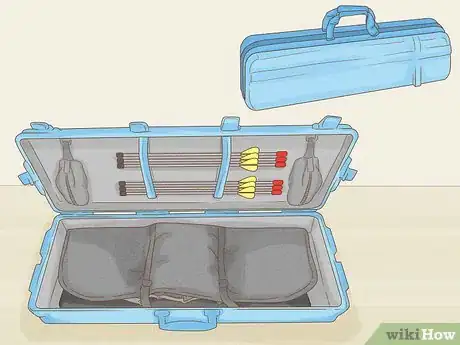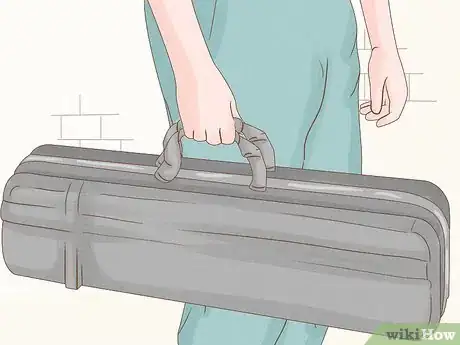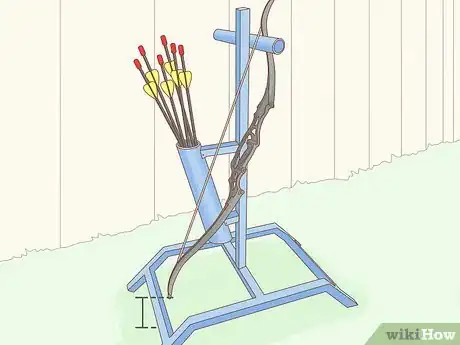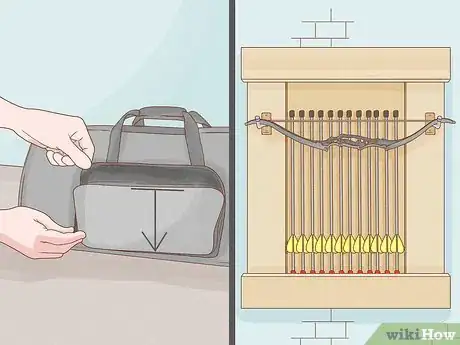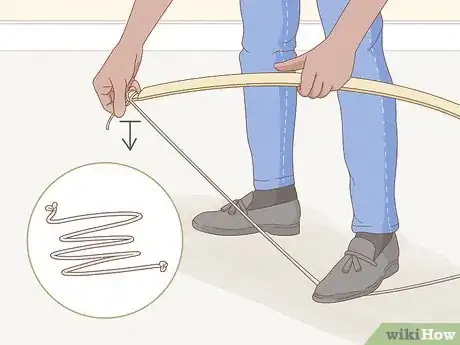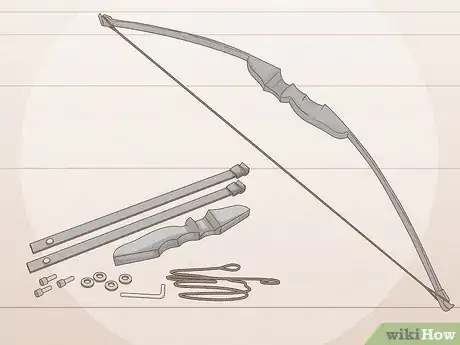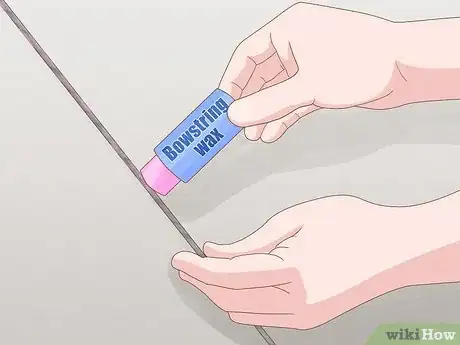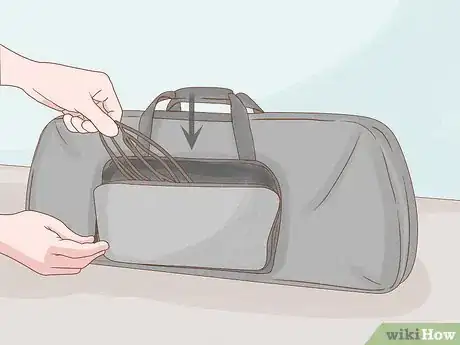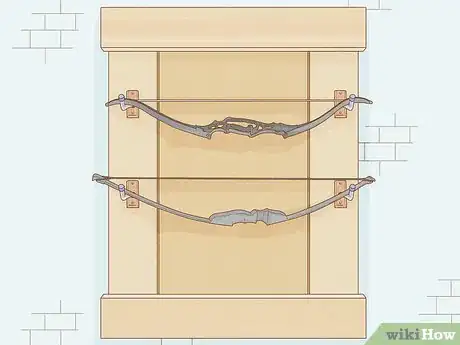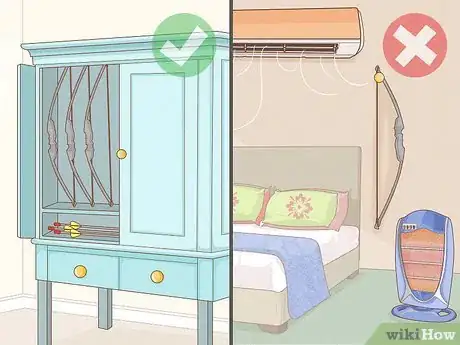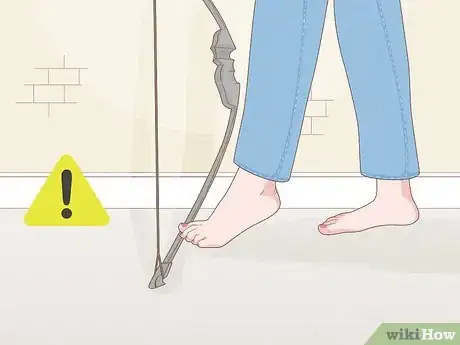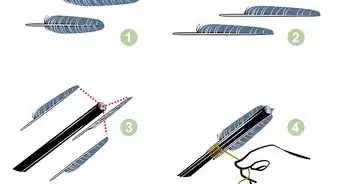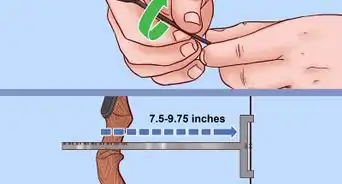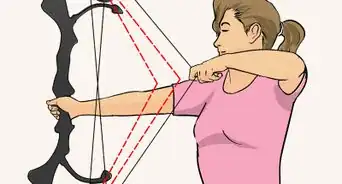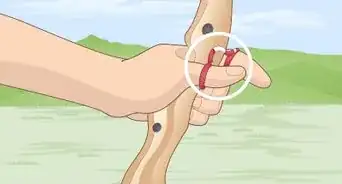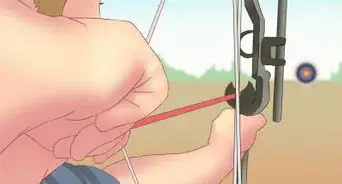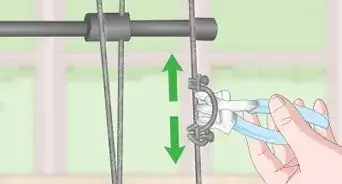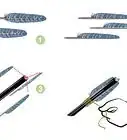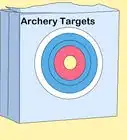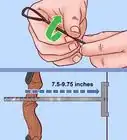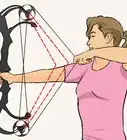This article was co-authored by wikiHow Staff. Our trained team of editors and researchers validate articles for accuracy and comprehensiveness. wikiHow's Content Management Team carefully monitors the work from our editorial staff to ensure that each article is backed by trusted research and meets our high quality standards.
There are 16 references cited in this article, which can be found at the bottom of the page.
This article has been viewed 11,288 times.
Learn more...
Getting a cool new bow is a lot of fun, but figuring out what to do with it afterward can be confusing. If you’re tempted to lean it in a corner of your room, you risk causing permanent damage to it. Fortunately, storing a bow really isn’t that difficult when you have the right case or mount. Be sure to store your bow properly whether you’re at home or at a shooting range. You paid good money for it, so make it last as long as possible by storing it properly.
Steps
Picking a Storage Unit
-
1Choose a storage option that is large enough to hold your bow. To determine what storage size your bow needs, measure it from end to end. Also, measure its width. Keep in mind that cases and holsters come in a variety of different sizes. The type of bow you have will also affect what case size you have to get.[1]
- If you have a compound bow, you won’t be able to remove its string. Make sure the case or mount you get fits the shape of your bow as well as its length.
- Recurve bows can be left strung or be unstrung before storage. If you have a recurve bow, its ends, or limbs, curve away from you when it’s unstrung, so keep that in mind when choosing a storage method.
- Takedown recurve bows are always unstrung before they are stored. In addition, you can separate one into multiple pieces, which means you can get a more compact mount or case.
-
2Buy a soft case for general transportation and storage. Soft cases are made from damage-resistant fabric. They come in a variety of shapes and sizes, so you can find a suitable one no matter what kind of bow you have. Soft cases are the best option when you’re looking for something decent and reasonably priced that you can use every day. Most of them also have side pouches that give you plenty of room to store arrows and accessories.[2]
- Basic soft cases are available for as little as $10 to $20 USD.
- One of the main benefits of soft cases is that you can use them to carry your bow as well as store it long-term at home.
- Although soft cases hold up well outdoors, they aren’t damage-proof. The fabric will eventually start to fray. They don’t last as long as hard cases.
Advertisement -
3Get a hard case if your bow needs additional protection. Hard cases are made of plastic, so they are more damage-resistant than other types. If you set something on top of the case, you won’t have to worry about it damaging your bow. Hard cases also work well if you take your bow into harsh outdoor conditions, like if you hunt. Most of them also are big enough for you to store arrows and accessories with your bow.[3]
- Some basic hard cases cost $25 to $30. Many others cost double or triple that.
- A hard case comes in handy when you’re short on room. For example, if you live in a small apartment, pack your bow into a full car, or even take it on a plane, the extra support helps a lot.
-
4Use an archery backpack if you want more portability. Archery backpacks are special padded backpacks designed specifically to carry bows, although they can also be used for storage. If you have a backpack, you could hang it up or even rest it in a safe spot inside your home. Backpacks are much softer than cases, so you have to be careful to avoid crushing your bow. However, if you need a way to store your bow while you’re on the go, a backpack could be your best option.[4]
- Some backpacks cost as little as $40 to $50. There are also high-end ones that cost over $100.
- Backpacks are best for hunters or people who go on cross-country trips. You may not be able to lug around a case, so a backpack is the only way to protect your bow.
- Backpacks work best for recurve bows, particularly ones that come apart. Some backpacks can hold an assembled bow.
-
5Use a bow stand to keep your bow off the ground. Bow stands are similar to camera tripods. You set the bow stand on the floor, then mount the bow on top of it. It is a good way to keep your bow safe for both short and long-term storage. However, it leaves your bow out in the open, so you could still potentially damage it if you’re not careful.[5]
- Bow stands are very inexpensive. You can get a basic one for $7 to $12.
- Bow stands are mainly used to store stringed bows. Standing the bow on the ground could deform it. It can be used for unstrung bows, too.
- Bow stands are small and cheap. Plus, you can take yours with you when you go out to shoot.
-
6Install wall pegs or mounts for a way to hang your bow. The simplest way to mount a bow is by getting a pair of pegs and hammering them into a wall. Rest the bow on top of the pegs so it’s safe but readily accessible. For a more decorative option, invest in a bow rack. Racks also have pegs that safely prop up your bow.[6]
- Pegs and racks cost around $14 to $60.
- Hanging pegs have to be spaced evenly apart so each one supports half of the bow’s weight. Otherwise, they could warp its structure.
- Wall hangers are only useful at home. You will still have to get a separate carrying case for when you take your bow outdoors.
-
7Get a mount or case with extra storage if you have accessories. Some extra gear you might store includes arrows, spare string, an arm guard, gloves, and string wax. If you plan on carrying extra, make sure you have room for it. The extra gear can often be stored with your bow, and many cases have side pockets you can take advantage of to keep everything organized. More basic storage systems, like stands and mounts, won’t have this luxury.[7]
- Be careful when using a very compact case, since you might not have room to store everything you wish to keep with your bow.
- Some accessories, like sights and silencers, come in a storage tube. If you have accessories in storage tubes, determine if you can include the tubes in your bow’s case.
- Another option is to carry accessories separately from your bow. Buy separate carriers as needed. For example, get an arrow tube to carry arrows or a tacklebox to carry tools.
Packing a Bow for Storage
-
1Remove the string if you have a wooden bow. Wooden recurve bows deform when you leave them stringed for long periods of time. To prevent this, attach an accessory called a bow stringer to the bow’s ends. Pull it down to the floor and hold it down with both of your feet. Lift the bow until the string is slack, then untie it to detach it from your bow.[8]
- A recurve bow is a traditional bow that has a string and no extra parts. One way to tell apart recurve bows is by looking at the ends. They will curve away from you when the bow is unstrung.
- Compound bows are made of aluminum or carbon and have pulleys that hold the string in place. With this kind of bow, you never have to remove the string unless you’re replacing it.
- Plenty of modern recurve bows are made of synthetic material. They are stronger than wooden bows, so you don’t really have to remove the string unless you’re storing the bow long-term, like for over a month.
-
2Pull apart takedown recurve bows for easier storage. Check the manufacturer’s instructions for specific information about how the bow comes apart. Generally, you have to loosen the string first using a bow stringer. Then, untie the string to store it separately. Finally, use an allen key or a wrench to remove the bolts holding the limbs together.[9]
- Takedown recurve bows are the only kind meant to be broken down into smaller pieces. If you have one, you can pull it apart for easier storage.
- You don’t have to take apart your bow if you’re keeping it in a large case or mount. Even if you have a takedown recurve bow, leaving it whole is fine.
-
3Clean the bow by wiping it with a microfiber cloth. Wipe down each piece, including the string, to remove any debris left on the bow. To remove stubborn debris, you could apply an automotive polishing compound. Rub it over the bow with a microfiber cloth. Clean any accessories you plan on storing with the bow, too.[10]
- You should do this every time you finish using your bow. That way, it is less likely to get damaged in storage. It will also ensure your bow lasts longer.
- Automotive polish is also great for getting rid of things like mildew that could grow out of hand while your bow is stored. Make sure your bow is completely clean and dry!
-
4Polish the bowstring with a stick of bowstring wax. Peel back the wrapping on the wax stick, then press it against the string. Rub it gently along the entire string on both ends until it is well-coated. Then, use your fingers to massage the wax deeper into the string. When you’re done, you shouldn’t be able to see any visible wax left on the string.[11]
- Wax prevents the string from fraying or absorbing moisture while it’s in storage.
- To make your string last, wax it about once every 2 weeks. If it starts to feel rough or dry, give it a fresh coat of wax.
-
5Store the bow parts inside the pockets if you’re using a case. Store the bow according to the kind of storage unit you have. Generally, cases have a big spot in the middle where you rest the bow on its side. Place the accessories, such as arrows or signs, in separate side pockets.[12]
- Keep the main parts of the bow together. If you have a takedown bow, the bow’s limbs and string all fit together. Some cases have separate slots for each part.
- Accessories usually can be stored inside the case. Many of them come with individual storage tubes, or you can buy extra storage tubes if you wish to use them.
-
6Hang the bow so it’s off the ground if you have a mount. For stand-type mounts, set the bow so its outer edge is up against the mount. Make sure the bow is off of the ground so it doesn’t get damaged. For hanging mounts, slide the bow on top of the mount’s pegs. The bow will rest on top of the pegs and won’t ever come close to the ground.[13]
- No matter what kind of bow you have, you can hang it. They all hang the same way. Hanging is a good option if you use your bow frequently, since you can just pull it off the wall and go.
- Hanging a bow successfully is all about balancing its weight. Hanging pegs have to be the same distance from the bow’s ends so its shape doesn’t change in storage.
- Accessories usually have to be stored separately from the bow. You can keep them in individual storage tubes or in a bow case.
Selecting a Safe Storage Spot
-
1Pick a cool spot where the temperature is stable. For example, move the bow to the back of a dark closet or put it on a stable shelf. You could also leave it out in a room that stays consistent throughout the day, especially if you’re hanging or mounting it. Try to avoid extreme temperatures or any locations where the temperature could change a lot over time.[14]
- For example, keep your bow away from heaters and air conditioners. The temperature change could damage it, even when it’s in a case.
- Never leave your bow in a hot car. The heat will cause your bow to warp over time.
-
2Keep the bow away from moisture and humidity. For safety, it’s important to store your bow in a climate-controlled area. You shouldn’t leave it in a garage, for instance, or a damp basement. Move it away from water sources, such as leaky pipes or air conditioners. Make sure it won’t get wet while it’s in storage.[15]
- Water is very bad for wooden bows, but it will also ruin synthetic ones. It causes the bow to warp and could cause mildew to grow on it.
-
3Choose a spot where the bow won’t get stepped on. This can be a big problem if you’re keeping your bow in a soft case or backpack. You could easily crush the bow just by setting something heavy on top of it. Try to keep the bow in an area where it won’t get damaged, such as on an empty shelf in a closet. If you put it up high, make sure it can’t be knocked down.[16]
- If you’re hanging or mounting your bow, make sure that it is secure on its storage unit. Otherwise, it could be knocked to the floor when you’re passing by.
- Be careful when carrying your bow in a car, on an airplane, or in another crowded spot. It could easily get crushed. It’s best to keep the bow in a hard case when it will be in tight quarters.
-
4Pick a spot where children can’t reach the bow. It’s better to put the bow up high to prevent it from getting damaged. Move the bow, in its case, up onto a high shelf or hang it on a wall mount. Store the arrows separately as well. Doing this will ensure that your home is safe.
- If you have pets, put the bow up for safekeeping as well.
- If you have a compound bow, take extra care to keep it out of a child’s hands. Since you don’t have to remove the string, it will always be ready for use.
Warnings
- Improper storage can damage your bow. To keep your bow in good condition for as long as possible, always take time to clean it and put it away when it isn’t in use.⧼thumbs_response⧽
- Take care to store arrows where children can’t reach them and pick them up after you’re done firing them. They are sharp and can cause serious injury, even when they are on the ground.[18]⧼thumbs_response⧽
- For safety, don’t use a bow near your home or in an area where other people might be. Take it to an archery range or another spot where it is legal to use.⧼thumbs_response⧽
Things You’ll Need
- Bow storage case
- Microfiber cloth
- Storage tubes (optional)
- Automotive polish (optional)
References
- ↑ https://www.youtube.com/watch?v=RaDdKa8bhgQ&feature=youtu.be&t=55
- ↑ https://www.youtube.com/watch?v=TZzgBze3-2o&feature=youtu.be&t=69
- ↑ https://www.youtube.com/watch?v=TVl1Dn6zzZ0&feature=youtu.be&t=119
- ↑ https://www.youtube.com/watch?v=TZzgBze3-2o&feature=youtu.be&t=291
- ↑ https://www.youtube.com/watch?v=b22E7Epzb1U&feature=youtu.be&t=33
- ↑ https://www.oneprojectcloser.com/how-to-build-a-bow-rack/
- ↑ https://www.youtube.com/watch?v=q4e3XNTj3fw&feature=youtu.be&t=35
- ↑ https://www.state.nj.us/dep/fgw/pdf/education/nasp_restring.pdf
- ↑ https://sfyl.ifas.ufl.edu/media/sfylifasufledu/orange/4-h/docs/pdf/Archery-Novice-Project-Book.pdf
- ↑ https://www.youtube.com/watch?v=z01kVc6QUJ4&feature=youtu.be&t=185
- ↑ https://sfyl.ifas.ufl.edu/media/sfylifasufledu/orange/4-h/docs/pdf/Archery-Novice-Project-Book.pdf
- ↑ https://www.youtube.com/watch?v=6BVt-yhyoNI&feature=youtu.be&t=132
- ↑ https://www.youtube.com/watch?v=OTRZWeFeR9c&feature=youtu.be&t=42
- ↑ https://www.michigan.gov/documents/dnr/Michigan_Curriculum_4_and_5_176161_7.pdf
- ↑ https://www.michigan.gov/documents/dnr/Michigan_Curriculum_4_and_5_176161_7.pdf
- ↑ https://www.youtube.com/watch?v=OTRZWeFeR9c&feature=youtu.be&t=30
- ↑ https://fyi.extension.wisc.edu/uphamwoods/files/2019/05/Archery-Lesson-Plan-2019.pdf
- ↑ https://pubmed.ncbi.nlm.nih.gov/22648468/
